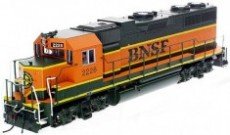Everything on model trains, model railroads, model railways, locomotives, model train layouts, scenery, wiring, DCC and more. Enjoy the world's best hobby... model railroading!
The Vermont & Essex Railroad Club
 Daniel sent in this article for publication:
Daniel sent in this article for publication:
I’m a member of a private club called ” Chemin de fer Vermont & Essex “.
The Vermont & Essex railroad club became a reality in 1998 when six passionate modelers formed a private club depicting various train routes from Montreal to Boston across the Vermont landscape. The photo you see above is the actual model of the St-Albans’ station on our layout, with it’s train shed measuring a mammoth 404 scale feet!
GP5 Loco and Tender by Graham Fisher
Marks asks readers:
“I have what I think is a GP5 loco and tender by Graham Fisher. I am in serious need of a lot of parts. The motor is in good order and all parts move. There is no body on either the loco or tender. Does anyone know where I can access detailed pics?”
HO Bridges – Trestles
Gary has a question for readers:
“I have two track spans, both about 3 feet long. One is single track, the other, double track. These are elevated so they need bridges or a trestle. I can’t find anything commercially, so I would like to build it from scratch. This will be my first scratch building effort. Where can I get info on plans and materials available to use for such a project?”
N Gauge Kato Number 4 Points
Mike has a question for experienced model railroaders:
“I have a passing loop with a sidings coming off the loop. When I switch the rails to move a loco up the siding the loco in the loop moves as well. Any answers please?”
Comment below.
Tunnel Derailments
Ralph is experiencing derailment problems and asks readers for advice:
“I have a curve in a tunnel. When the train runs right to left on the track all is well. But when I run the train left to right I obtain a derailment. I have manually changed the curvature a little. The area is somewhat accessible. There is no problem either way with small engines just with the longer engines.”
Comment below.
N Gauge DCC Conversion
Evert has a question for readers:
“I live in Cape Town, South Africa. I’m busy building a layout for my N Gauge trains. I’;m sitting with a bit of a problem as nobody can help me converting my locos to DCC. I have 2 of the following : Kato N 2016-1 D51 2-8-2 Japanese Steam Locomotive #498. Can someone please help me ? I have no idea what to do and I can’t even get the loco open. Thank you very much.”
Add your comment below.
Converting Old DC Model Railroad To DCC
Henry has a question for readers:
“My old DC railroad is about 20 years old and is needing a facelift. Can it be changed to DCC without a lot of new wiring? I have several blocks so that I could control trains in different areas. Do I need to remove the blocks and make it all one block? Lastly, can my old engines be converted to DCC or do I have to buy new dcc equiped engines?”
Comment below.
N scale, but No Locomotive Or Cars
Cecil has a question for readers:
“I have a lot of track but no locomotive and no cars. 23.456 ft of track. I go to e bay a try to get things but get out bid. What do I do to get what I want? I don’t want to sell any of my track. I want to make a big layout. What to do?”
Frogs And Switches
George has a question to test experienced railroaders and asks:
“Why do the frogs in the switch keep derailing my engine or cars. I have checked the tension of the Atlas switch, and I also have Bachmann N gauge which does the same thing.”
Add your comment below.
Ballasting Track – Excellent Tips To Execute A Perfect Job
Ballasting Track can be quite tricky and it takes at most patience and effort to get it looking right. Ballast is laid between the tracks and sometimes on the sidings of the sleepers such that one can in a realistic effect there are different techniques for laying down Ballasting Track.
If you are using cork it is important that you stand the edges of the slope first so that the smaller stones will obey better. Use almost 70% isopropyl alcohol spray as the wetting agent instead of plain water.
With the help of an eyedropper you can do a better job and avoid spraying on the scenery. To soak the Ballasting components use a mixture of white glue and alcohol in 50-50 proportion. These tips will help you do your job perfectly.
You’ll get a more detailed guide to step by step ballasting in the members area at the online Model Train Club.
Model Train Track Codes – Know The Exact Specification Of Your Prototype
Each model train track comes with various codes or sizes for each scale. These codes are identified with numbers which translate into the height of the rail track in inches. For example: Code 100 – gives you 0.1 inch height and 156lb rail. In the same way, Code 83 – gives you 0.083 inch height and 132 lb. rail.
When it comes to creating a prototype track, the main lines are made with heavier rails and the branches or deviations are made with lighter rails. The roadbed and the space between ties of these codes vary as well. For example if the mainline needs 24 ties/39 foot rails, it comes down to 11 1/2 inches between each tie. With this in mind, use heavy code rail for the mainline and smaller code for the sidings.
Blog Now More User Friendly – Thanks For Your Feedback!
We recently ran a reader poll asking “Do you know how to add a comment (or answer) to a posting on this blog?”
We were staggered with the results. Despite our techies insisting the method for posting comments was easy to use, a massive 63% of readers disagreed and said they didn’t know how to post a comment on the blog. Shock! Horror! We had no idea there was such a problem.
The New Easy Way To Post Comments
To fix things we now include two links directly UNDER EACH POSTING where readers can post a comment or ask other readers a question. The links appear under EVERY posting so they are easy to find. Obviously to keep the quality of posting high (and to avoid unwanted spam comments), all comment need to be reviewed and approved by the blog moderator. This is a quick process and most comments will be live within a few minutes or few hours.
So, there is no excuse for not having your say and getting involved in the discussions on this model train blog. It is now really easy to have your say and share your ideas.
Model Railroad Bridge Installation, Bridge Abutments, Pier Foundations
 Tom has a question for readers:
Tom has a question for readers:
“I need help on installation of N scale bridges. I specifically require help on preparing the roadbed, bridge abutments, and pier foundation. I recently completed a Pratt Truss Bridge kit, and two deck bridges. Can someone advise please?”
To guide Tom, please add your comment here on this posting.
Getting Started In DCC
Ed has a question for readers:
“I am looking for some help in choosing a power pack to start my model railroad. I have seen all of the features and eventually want to go to DCC and hand held but not now. So can someone suggest a reasonably priced power pack that will allow growth?”
To post your question use the link in the right hand column. To comment on this posting, click on the link in this posting.
A Haunted House For Your Model Trains
 John has very kindly contributed this article to help others in the hobby…
John has very kindly contributed this article to help others in the hobby…
Halloween is almost here, and there’s no better time to add an old/haunted house to your train layout. What’s better, you can do so at little cost, and even use materials that can be found outside, such as broken-off tree branches, weeds, moss, etc.
I used an N-Scale Model Power built-up Haunted House shown in the photo. The house itself comes a bit off-kilter, making it perfect for this purpose, though the exterior is a cream color with green shutters and a black roof. To weather the bright colors I used some black paint cut with a small amount of water, and blackened the exterior of the house to simulate dirt, grime, and overall wear, making it look like it should be torn down and rebuilt. The fall colors are in season, and Woodland Scenics trees are great for this, as well as fallen branches.
You can add a lot of detail if you work in the larger scales like HO or O. Put in broken windows, leaves, doors off their hinges, and ghosts, bats, and various beasties that go bump in the night. But the main purpose is that a modeler can use any house for this if you “beat it up” and make it look misused and run-down.
By putting a haunted house on your layout, it’s certain that a slow-moving freight train will go a lot faster as it passes the house, not sure of who (or What) lives inside!
Click the link if you would like to add a comment to John’s posting.

















